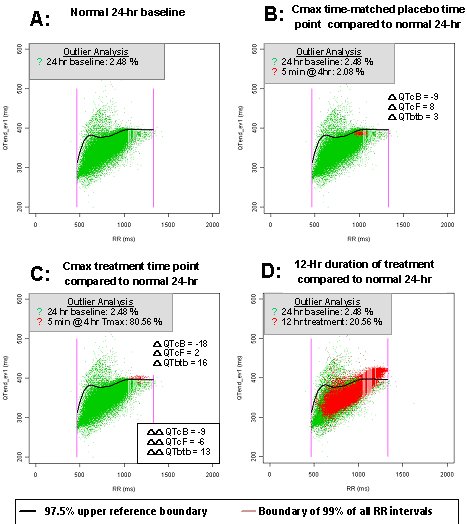Newsletter Issue 9, July 2010 |
|---|
QT evaluation for drugs with autonomic effects & other Scientific activities |

- Editorial
- The dynamic beat-to-beat QT method
- Holter bin Analysis
- THEW New database: IMMEDIAT AIM study
- Profiling the THEW Team: Kelley Cenname
QT/QTc Evaluation for Drugs with Autonomic Effects (part I)
by JP. Couderc, PhD
The incidence of torsades de pointes following the administration of antipsychotic and other CNS drugs remains unknown but the risk of sudden cardiac death is estimated to be 15/10,000 persons per year. In thorough QT studies, the potential interaction between drug effect on the ANS and the QT interval may lead to biased estimate of QT effect, and wrong designation of a drug as a QT prolonger. Consequently, QT assessment methods specifically designed to address the issue of heart rate effect on QT need to be considered. This was pointed out by FDA regulators at many occasions including Dr. Christine Garnett (FDA/CDER) during the THEW Cardiac Safety Meeting in Silver Spring, MD, this past year ( slides available for download here ). Dr. Garnett emphasized the need for looking at continuous ECG information either through telemetric or Holter recordings. Today, the methods evaluated by the Agency are: individual correction (QTci), RR bin and QT beat-to-beat methods. Two of these methods are presented in depth in this newsletter by their respective inventors. The QTci and associated QT/RR modeling technologies will be presented thoroughly in the next release of this Newsletter.
Interestingly, the RR binning and QT beat-to-beat methods are increasingly used in thorough QT studies involving drugs with an autonomic effect. Drs. Badilini and Fossa describe with great expertise these methods in the next sections of this newsletter. These articles are available (full versions) in the Expert Opinion section of the THEW website ( here ) . In parallel, the FDA/CDER released an offer for a 2-year fellowship at the FDA campus to ensure that the Agency is ready to receive results from such methodologies (large set of measurements from continuous ECG recordings). A copy of the fellowship postion is available here .
Also in this Newsletter, this first semester of 2010 marks the first set of scientific presentations based on data from the THEW. As announced in our previous Newsletter, we confirm that the program of the next Computing in Cardiology Meeting to be held in Belfast (UK) this September will include a session dedicated to the works developed exclusively using the data from the THEW. The Agenda for this session entitled "QT and Cardiac Repolarization" was designed by the organizers as follow:
- Analyzing Thorough QT Study 1 & 2 in the Telemetric and Holter ECG
Warehouse (THEW) Using Hannover ECG system (HES®): A validation
study Antoun Khawaja*, Ratko Petrovic, Anton Safer, Tobias Baas, Olaf Doessel and Ronald Fischer. -
Torsadogenic Drug-Induced Increased Short-term Variability of JT-area
Xiao Jie*, Blanca Rodriguez and Esther Pueyo -
Electrocardiographic Markers Associated with Sotalol-induced Torsades
de Pointes Jean-Philippe Couderc*, Xiaojuan Xia, Stefan Kaab and Wojciech Zareba -
Comparison of Three T-end Delineation Algorithms Based on Wavelet
Filterbank, Correlation and PCA Tobias Baas*, Franz Gravenhorst, Ronald Fischer, Antoun Khawaja and Olaf Dössel - QT/RR Coupling and Gender Differences. Josef Halamek*, Pavel Jurak, Jolana Lipoldova and Pavel Leinveber
-
Modified Rectangular Finite Impulse Response Filter for Stabilization of QT
Measurement. Jing Wu, Jean-Philippe Couderc* and Xiaojuan Xia
In addition, the works from students whom have taken the THEW training program this past December will be presented in various poster session as well:
- A Comparison of IIR and Wavelet Filtering for Noise Reduction of the ECG
Jens Stampe Soerensen*, Lars Johannesen, Ulrik Silvanus Lerkevang Grove,
Kasper Lundhus, Jean-Philippe Couderc and Claus Graff -
Analysis of Heart Rate Adaptation in Long-Term ECG Recordings Using
RR-Binning Lars Johannesen*, Ulrik Silvanus Lerkevang Grove, Jens Stampe Soerensen, Mick Lykkegaard Schmidt, Claus Graff and Jean-Philippe Couderc - Wavelet-based Algorithm for Delineation and Classification of ECG Waves
Lars Johannesen*, Ulrik Silvanus Lerkevang Grove, Jens Stampe Soerensen, Mick Lykkegaard Schmidt, Jean-Philippe Couderc and Claus Graff
These works represent the first scientific publications from various private and public organization members of our initiative. We would like to congratulate these scientists and students for the interesting research work they have generated based on the data from the THEW repository. We hope that the new database we have added this month (described in details below) which contain Holter recordings from more than 1,150 of chest pain patients from the IMMEDIATE AIM study will spawn additional research works from our members.
The dynamic beat-to-beat method by Anthony Fossa, PhD
The dynamic QT beat-to-beat (QTbtb) analysis has been reported to differentiate changes of QT interval duration due to heart rate or autonomic state from impaired repolarization. This work has recently been reviewed with both clinical [1] and preclinical translational data [2,3]. The method utilizes all individual cardiac cycles from continuously collected ECG telemetric or Holter data to define the normal baseline which contains different autonomic states experienced over 24-hours. The baseline QT-RR boundaries therefore also contain beats incurred during all normal hysteresis (defined as the lag in QT interval adaptation for changes in RR interval), sinus arrhythmia and QT-RR variability during activities such as eating, sleeping and ambulatory movements. The upper confidence bound for the baseline of all beat-to-beat QT interval values is defined across the entire 24-hr RR interval range and beats exceeding this limit are flagged as outlier beats for further arrhythmia vulnerability assessment. These beats would be assumed to possess potential risk of arrhythmia and can be further analyzed by quantifying the temporal heterogeneity or assessment of ECG restitution of the entire dataset (described below).
Using the individual 24-hr pre-dose data as a baseline for all subsequent analyses (
Figure 1
, panel A), the effect of a drug, placebo and baseline-adjusted placebo corrected value can be readily assessed. For any specific time point or timeframe, all continuously collected viable beats are analyzed with rigorous automated quality control procedures. This is usually a 5 minutes period during drug administration and its time-matched placebo (
Figure 1
, panel B). The center of this 5-min cloud of data or centroid is calculated as the median QT and the median RR interval (
Figure 1
, panel C). This median QT value (QTbtb) value for any nominal time point is compared to the centroid of all beats extracted within a similar RR interval range (e.g. ± 12 ms) from the 24-hr baseline dataset to provide a delta-QTbtb value (
Figure 1
, Panels D, E and F).
FIGURE 1

The beats used to calculate the delta-QTbtb for the nominal time points can also be used for calculating the corrected QTcB or QTcF values for simultaneous comparison (
Figure 2
). The same procedure used to define the delta-QTbtb value for placebo can then be applied for the on-drug treatment nominal time points. The placebo-adjusted time-matched values (delta-delta QTbtb) are simply calculated by subtraction of the time-matched placebo values from the same time-matched values on treatment from the same subject. However, one advantage of using continuous ECG collection with beat-to-beat analyses is that entire timeframes of data when on-drug can be compared to off-drug periods to quickly determine whether an effect is present by the outlier methods described below (
Figure 2
, panel D).
An essential component of the beat-to-beat method is to determine whether repolarization is significantly impaired beyond normal autonomic boundaries by applying quantile regression techniques to define the upper 97.5% reference boundary of QT over RR intervals from the normal 24-hr data (See
Figure 2
from baseline day of the study).
FIGURE 2:

An outlier analyses examines the percentage of beats that exceed the upper 97.5% reference boundary of the baseline data during any period. By definition, for a drug with no effect this percentage should be around 2.5 % of beats exceeding the upper boundary. The % outliers values can be handled as described above for QTbtb values and thus a time-matched placebo adjusted value can be obtained for each time point. A lower 90% two-sided confidence interval can be determined for the mean of the % outlier values at any time point to determine whether there is a statistically significant increase in outliers. As mentioned above, this same type of analysis can also be conducted for any period of time that the drug is used, including the entire time at efficacious concentrations to readily ascertain the net effect of drug vs. normal QT/RR relationship.
Arrhythmia liability due to changes in temporal heterogeneity of outlier beats can be assessed by a bootstrap analysis applied only to beats that exceed the upper 97.5% reference bound. The median value during any time period on-drug is determined to ascertain whether these beats are of greater magnitude in general compared to beats normally exceeding the upper 97.5% reference bound of QT intervals off-drug. Bootstrapping provides confidence intervals of the median value. The width of the confidence intervals is used as a measure of heterogeneity of the QT interval outlier beats, which has been associated with increased arrhythmia liability and can be compared to the width of the confidence intervals at normal levels from the same individual when obtained off-drug.
A second procedure to evaluate arrhythmia liability of temporal dynamics is to evaluate the cardiac ECG restitution. Restitution is the ability of the heart to recover from one beat to the next. This measures the QT interval (working phase of the heart) in relationship to the previous TQ interval (resting phase of the heart). When the heart is not under stress, this ratio is less than 1, meaning the heart is resting more than it is working. However, as stress increases on the heart, for example, during exercise, the heart works more than it rests, increasing this ratio to greater than 1. Sustained periods with inadequate recovery between beats would presumably lead to increased arrhythmia vulnerability as occurs in extreme cases with salvos of non-sustained ventricular tachycardia or an R on T phenomenon where TQ interval equals zero. Arrhythmia liability not associated with QT prolongation may be more related to the TQ interval shortening or increase in the QT/TQ ratio of each beat. When QT prolongation is present along with increase QT and RR variability or increased heart rate during proarrhythmic states, the QT/TQ ratio can increase dramatically for transient periods of time possibly leading to initiation of reentry. Thus in addition to the median QT interval, the median TQ interval and median QT/TQ ratio are assessed in ECG restitution. Other parameters to describe length of stress and magnitude of extreme changes are defined as % beats greater than 1 and upper 98% bounds for the QT/TQ ratio, respectively.
Reference for this article can be found here .
Holter RR Bin Analysis by Fabio Badilini, PhD
Holter bin is a method used to quantify changes of electrocardiographic metrics from continuous recordings. This technique was introduced to characterize repolarization patterns in healthy subjects (1) and it has been applied to study several pathological conditions (2,3) and for the assessment of drug-induced ECG changes (4), particularly in the presence of heart rate changes (5).
Holter bin is based on the concept of selective beat averaging. An exploring time window is initially defined; within this time window all the cardiac beats characterized by the same preceding heart-rate (or RR interval) are pooled and averaged to form a representative waveform for that specific RR interval (or RR bin). When the variable of interest is the QT interval, the rule of selection can be tailored to meet further conditions, as for example to take into account (or to compensate for) the effect of hysteresis: for example excluding all the cardiac beats not preceded by stable heart rate or, alternatively, using the hysteresis-corrected RR interval by a mathematical model as the bin-inclusion parameter.
Holter bin requires adequate signal processing; for example the precise position of each cardiac beat should be properly verified and automatically adjusted (trigger jitter correction); at need, the individual cardiac complexes may need to be re-interpolated to improve the respective alignment before averaging. The exploring window should be rigorously controlled: for example, diurnal and nocturnal periods and, more in general, regions with known modified autonomic tone (for example exercise periods) should not be mixed in the same Holter bin session. The ideal length of the exploring window depends on the specific experiment. In the case of pharmaceutical trials, a 2 to 4-hours window centered at peak concentration has been typically used (4).
Holter bin is particularly suited to inspect metrics that need to be compared in conditions or maneuvers that modify the hart rate, for examples when comparing the effect of repolarization on drugs that change the baseline RR interval (5). Rather than enforcing the application of one or more QT/RR models models, the approach assesses changes by comparing the study parameters (e.g. QT interval) belonging to the same RR-bin, i.e. enforcing a comparison at identical heart-rate, thus avoiding the application of correction formulae.The typical output of a Holter-bin analysis session is typically a set of comparisons associated with each of the RR bins inspected
: for example (in the context of a QT study) the averaged and the maximum QT difference across all the RR bins could be reported. Within-bin variability is important and can be assessed by several indicators such as the bin "density" (i.e. number of cardiac beats pooled inside each bin) or the variability of some parameters the individual beats included into the bin (for example SD of the beat-to-beat QT intervals).
Pros
- No need to implement correction models
- Good to assess changes associated with moderate (up to 10 bpm) heart rate changes, where the degree of RR overlap between baseline or placebo and on-drug is significant.
- QT hysteresis can be easily controlled.
Cons:
- Within the exploring window cardiac beats are pooled according to the preceding heart rate and the time-scale is lost.
- Requires sophisticated beat-to-beat processing including appropriate quality control of automated ECG analyses
Reference for this article can be found here .
New database available in the THEW including 1,154 subjects from the Emergency Department for Chest pain: IMMEDIAT AIM study

The THEW has signed an agreement with University of California San Francisco for transferring the data from the IMMEDIATE AIM (Ischemia Monitoring and Mapping in the Emergency Department In Appropriate Triage and Evaluation of Acute Ischemic Myocardium) in to the THEW. This dataset includes digital ECG data recorded from 2001-2005 with Mason-Likar 12-lead Holter monitor devices (average length of recordings, 15.9 hours ± 9.0). The database includes 1154 subjects with 547 patients had a final diagnosis of acute coronary syndrome - ACS (105 with acute myocardial infarction; 178 with unstable angina), 607 with non-ACS cardiac diagnosis (e.g., heart failure, arrhythmia), and 271 had a non-cardiac diagnosis (e.g., gastrointestinal reflux disease). Demographic information, coronary risk factors, medical history and clinical data (serum troponin, cardiac catheterization, hospital length of stay and complications, transient ischemic events, and 1-year mortality) is available.
For more information please visit the database webpage here .

THEW Team: Kelley Concannon-Cenname, Clinical Technologist
Kelley Concannon-Cenname is a native of Rochester, N.Y and is a graduate of Monroe Community College with an Associate Degree in Science. Kelley came to the University of Rochester in 2008 and has 17 years of Cardiology experience. She is a Certified Electrocardiograph Technician, with expertise in rhythm interpretation. While currently enrolled at the Isabella Graham Hart School of Nursing, her primary roles in the THEW organization will be preparing and annotating Holter ECGs.